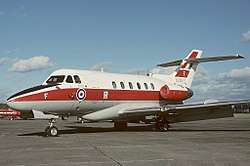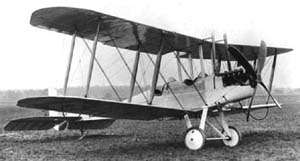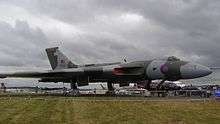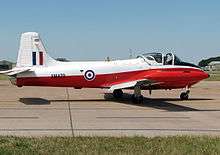RAF Finningley
Royal Air Force Finningley or RAF Finningley was a Royal Flying Corps and Royal Air Force station at Finningley, in the Metropolitan Borough of Doncaster, South Yorkshire, England. The station straddled the historic county boundaries of both Nottinghamshire and the West Riding of Yorkshire.
| RAF Finningley | |||||||||||
|---|---|---|---|---|---|---|---|---|---|---|---|
| Finningley, South Yorkshire in England | |||||||||||
 An RAF Hawker Siddeley Dominie T1 of No. 6 Flying Training School based at Finningley. | |||||||||||
 Usque ad cleum fines (Latin for 'Extending as far as the sky') | |||||||||||
 RAF Finningley Location in South Yorkshire | |||||||||||
| Coordinates | 53°28′47″N 001°00′39″W | ||||||||||
| Type | Royal Air Force flying station | ||||||||||
| Site information | |||||||||||
| Owner | Ministry of Defence | ||||||||||
| Operator | Royal Air Force | ||||||||||
| Condition | Closed | ||||||||||
| Site history | |||||||||||
| Built | 1915 | ||||||||||
| In use | 1915–1996 | ||||||||||
| Fate | Transferred to civilian use and became Doncaster Sheffield Airport. | ||||||||||
| Airfield information | |||||||||||
| Identifiers | IATA: FNY, ICAO: EGXI, WMO: 03360 | ||||||||||
| Elevation | 10 metres (33 ft) AMSL | ||||||||||
| |||||||||||
RAF Finningley was decommissioned in 1996. The airfield has been now developed into an international airport named Doncaster Sheffield Airport, which opened on 28 April 2005.
History
Origins

During the refurbishment of the Royal Flying Corps station at Doncaster in 1915 a decision was taken to move operations temporarily to an air strip at Bancroft Farm at Finningley.
This flight of aircraft is thought to have consisted of Royal Aircraft Factory BE.2c fighters. These fighters were used to intercept Zeppelin bombers approaching Yorkshire cities from the East Coast, in this instance, the heavily industrialised City of Sheffield.
Finningley became a Royal Flying Corps Military Airfield in 1915.
Second World War
Finningley's participation in RAF Bomber Command's offensive may have been short but the station played a vital part in finishing crews with operational training for the bombing role. An early pre-war expansion scheme airfield the site, farmland in a well wooded locality four miles southeast of Doncaster was acquired in the summer of 1935. The Doncaster-Lincoln railway line ran a quarter mile to the north and Finningley village lay a similar distance to the east. The flying field covered around 250 acres (100 ha) with the camp area situated to the northwest between Mare Flats Plantation and the A1 'Great North Road' (now the A638). Four Type C hangars were erected in the usual crescent layout facing the bombing circle, with a fifth directly behind the southernmost of the line. Administration and technical site buildings were immediately to the rear of the hangars.
Nos. 7[1] and 102[2] RAF Squadrons moved in during August 1936 from RAF Worthy Down with Handley Page Heyfords; this was earlier than the official opening date given in station records (3 September). During the next year, No. 7 Squadron split into No. 76 and No. 102 similarly divided to produce No. 77 the latter two soon being moved south to RAF Honington. No. 7 Squadron converted to Whitleys in March and April 1938 while No. 76 continued to operate Wellesleys, the type it had been formed to fly.[3] By the end of that year No. 5 Group completed its acquisition of No. 3 Group stations north of the Wash and, under its control, Finningley squadrons started conversion to the Handley Page Hampden, with Avro Ansons to fill out strength until more of this new type were available from production.[4]
The need to establish units devoted to training crews on the new bomber types resulted in the setting up of so-called pool squadrons during the summer of 1939. A revision of this arrangement brought the designated pool squadrons into operational training units and, shortly after war was declared, both the Finningley squadrons moved to Upper Heyford to form one of these organisations.[4]
Finningley was to continue in a training role for No. 106 Squadron, which brought its Hampdens from RAF Cottesmore in October.[5] Also classed as a reserve squadron, No. 106 continued the operational training role for No. 5 Group that the previous occupants had started to provide.[4]
During early 1940, Fairey Battles of 98 Squadron were moved to RAF Finningley from RAF Scampton.[6]
By August 1940 the critical war situation caused No. 106 to be placed on operational call. Most of its early sorties were to drop mines in the approaches to French Channel ports thought to be harbouring invasion barges. There was still need for a final polish for new Hampden crews and in February 1941 No. 106 left its 'C' Flight at Finningley to continue with this task while the rest of the squadron moved to RAF Coningsby for full offensive operations. While flying from Finningley, six Hampdens had failed to return. In March the former No. 106 "C" Flight metamorphosised into No. 25 OTU, initially continuing to train with Hampdens and Ansons. A few Manchesters arrived in the spring of 1941, and the unit was later bolstered with Wellingtons.[7]
Early in 1942 Finningley passed to No. 1 Group and with no further need for Hampdens or Manchesters No. 25 OTU concentrated on Wellingtons, nine of which were lost when the station was called upon to take part in Bomber Command operations. No. 25 OTU was disbanded in February 1943 and in March No. 18 OTU moved in from RAF Bramcote and began using RAF Bircotes and RAF Worksop as satellites. In November the Wellingtons were moved to these satellites as hard runways were to be laid at Finningley. These were put down during the winter of 1943–44, the main 03-21 being 2,000 yards (1,830 m), 07-25 4,200 feet (1,280 m) and 12–30 4,200 ft. A concrete perimeter track had been laid in The 1942 and asphalt pan-type hardstandings constructed in 1940–41 linked to it, two of the original clusters crossing the A614 road between Finningley village and Bawtry. A single loop-type standing was added to bring the total to 36. Some additional domestic accommodation was provided to cater for a maximum 1,592 males and 459 females. The bomb store was in Finningley Big Wood.
The station re-opened for flying in May 1944 when No. 18 OTU returned from RAF Bramcote. By the end of that year requirements for operational training had reduced and in January 1945 the OTU was disbanded and the Wellingtons removed.[8]
The Bomber Command Instructors School had been established at Finningley in December 1944 and this organisation, with a variety of bomber types, saw out the remaining months of the war at this station and did not depart until the spring of 1947. Navigational training was the main objective of No. 6 Flying Training School RAF, first using Vickers Varsity and later Hawker Siddeley Dominie aircraft. Although Finningley passed to Support Command in 1977, its training role continued throughout in the next decade before RAF activity was terminated.[9]
Sister RAF stations of RAF Finningley located in and around Doncaster included:[10]
Located at Bawtry Hall in Bawtry this was No 1 Group Bomber Command Headquarters and administration unit. The airfield at RAF Bawtry was operated by RAF Bircotes. RAF Bawtry became the centre of the RAF Meteorological Service and ceased military operations in 1986.
A satellite from RAF Finningley operating Avro Ansons, Wellingtons, and Manchesters from No. 25 OTU. Also operating No. 1 Group RAF Bomber Command HQ Communications Flight in support of RAF Bawtry
First opened in 1908 as one of the world's first airports, it took on biplane fighters during the First World War to combat German Zeppelins and later became a transportation squadron during the Second World War. The runway has now been lost to urban development; however a museum remains.
RAF Lindholme was home to the No 1 Lancaster Finishing School and between 1952 and 1972 was home to the Bomber Command Bombing School (BCBS), later Strike Command Bombing School and Air Navigation School.
An 850-acre (340 ha) bombing range used by No 25 and No 18 OTU at RAF Finningley during the Second World War. Post-war became a Bloodhound ASM battery location as part of 94 Sqn. Now private land. The location of the Bloodhound missile stands are still visible in aerial photographs.
A Lancaster Bomber dispersal airfield, taken over by the USAF in 1957. Part is now a commercial airfield, the rest is under industrial use.
Post Second World War
From 1946 to 1954 a number of different training units were stationed at Finningley with a variety of aircraft types. No. 616 Squadron RAF was re-formed at Finningley on 31 July 1946 equipped with de Havilland Mosquito NF XXX night fighters which were replaced with Gloster Meteor F.3 day fighters a few months later.
On the Monday 11 August 1952, a Meteor F.4 serial number RA376, located at RAF Finningley, and was one of the aircraft used by No. 215 Advanced Flying School RAF (AFS) had just taken off from the airfield for an exercise when it crashed close to Firbeck Hall in Nottinghamshire, approximately 8 miles (13 km) from the runway. A number of units withdrew in 1954 (including No. 215 ATS) leaving only the Meteors of No. 616 Squadron, Royal Auxiliary Air Force, manned largely by part-time personnel, but their days at Finningley were numbered for in May 1955 the squadron moved to RAF Worksop. The reason was that Finningley was about to be given a new lease of life as a V bomber station.
The Cold War years and after

During the next two years work was carried out to re-lay and extend the main runway to approximately 3,000 yards (2.7 km). Unit stores for atomic weapons were also constructed to house Green Grass in Yellow Sun, Violet Club and Blue Steel weapons. The airfield became known as the home of the 'V' Bomber after Avro Vulcans, Handley Page Victors and Vickers Valiants had all been stationed at the base. Finningley maintained its nuclear weapon storage facility for many years.
Finningley re-opened in the spring of 1957, No. 101 Squadron was re-formed in October that year to operate Vulcan bombers.[2] A year later No. 18 Squadron RAF with ECM Vickers Valiants was also established at Finningley.[11] In 1961, No. 101 Squadron RAF took its Vulcans to RAF Waddington[2] changing places with the Vulcan training organisation, No. 230 Operational Conversion Unit RAF.
It was two years from 101 Sqn leaving that in 1961, the Valiant having seen its day, No. 18 Squadron was disbanded.[11]
The Vulcan OCU stayed with RAF Finningley from June 1961 until December 1969.
In 1970 there was an arson attack on Number 2 Hangar by a serving RAF member. After the hangar was locked and secured at 1700hrs he lit a fire under an aircraft, obviously with catastrophic results. The hangar was badly damaged, and the perpetrator charged and imprisoned.
Handley Page Victor Bombers were added to the Finningley scene in later years before RAF Strike Command (the amalgamation of Bomber and Fighter Commands on 30 April 1968) moved its units out and Training Command took over the station in May 1970.
On 14 January 1992, a new Air Navigation School building was opened, built at a cost of £5.2m.[12]
Arguably the most famous of the Finningley's Avro Vulcan Bombers was aircraft XH558. On 1 July 1960 XH558 was the first Vulcan B.2 to enter RAF service and was immediately transferred to No. 230 Operational Conversion Unit at RAF Finningley before continuing its career. XH558 was restored to flight by the Vulcan to the Sky Trust and the aircraft was displayed during airshows until the end of 2015. On 29 March 2011 XH558 returned to Doncaster airport and Finningley, and she was once again at her original home. XH558 still resides there now, she remains in operating condition but without a permit to fly. Unfortunately, the three expert companies who were supporting the Vulcan in remaining airborne – BAE Systems, Marshall Aerospace and Defence Group and Rolls-Royce, collectively known as the ‘technical authorities’ - decided to cease their support at the end of the 2015 flying season. Without their support, under Civil Aviation Authority regulations, XH558 is prohibited from flying.[13] Since moving to Doncaster, the Vulcan and the Canberra has been removed from the hangar and have been left outside. Doncaster Council recently approved construction of a special built hangar for XH558 and WK163 but that will take years to construct.
Units
The following units were also here at some point:[14]
- No. 1 Group Communication Flight RAF
- No. 1 Group Standardisation Unit RAF
- No. 1 (Pilots) Refresher Flying Unit RAF
- No. 2 (Pilots) Refresher Flying Unit RAF
- No. 5 Group Pool RAF
- No. 5 Group Training Flight RAF
- No. 6 Anti-Aircraft Co-operation Unit RAF
- No. 6 Flying Training School RAF
- No. 7 Anti-Aircraft Co-operation Unit RAF
- No. 7 Blind Approach Training Flight RAF
- No. 9 Air Experience Flight RAF
- No. 18 Operational Training Unit RAF
- No. 21 Operational Training Unit RAF
- No. 25 Operational Training Unit RAF
- No. 64 Group Communication Flight RAF
- No. 101 Flying Refresher School RAF
- No. 202 Advanced Flying School RAF
- No. 215 Advanced Flying School RAF
- No. 230 Operational Conversion Unit RAF
- No. 1507 (Beam Approach Training) Flight RAF
- No. 1521 (Beam Approach Training) Flight RAF
- No. 1685 (Bomber) Defence Training Flight RAF
- Air Electronics, Engineer & Loadmaster School RAF
- Bomber Command Development Unit RAF
- Electronic Counter Measures Modification Centre RAF
- Flying Refresher School RAF
- Joint Forward Air Controller Training & Standards Unit RAF
- Multi-Engine Training Squadron RAF
- RAF Central Night Vision Training School RAF
- Sea King Command Engineering Development & Investigation Team RAF
- Search & Rescue Helicopter Wing RAF
- Strike Command Development Unit RAF
- Yorkshire Universities Air Squadron RAF
Facilities
Aircrew training

During the 1970s all RAF navigators passed through the Air Navigation School (ANS) of No. 6 Flying Training School (FTS) at RAF Finningley, when the BAe Dominie T.1 s of No. 1 Stradishall and the Varsities No. 2 ANS moved there from RAF Gaydon. In 1970, a Varsity aircraft caught fire in one of Hangars and subsequently destroyed 2 other aircraft by setting them ablaze. Low level navigation training took place on the BAC Jet Provost, eventually using the T.5A variant.
The Vickers Varsity was phased out in 1976 making No. 6 FTS an all-jet school.
RAF Finningley also played host to Multi-engine training and Operational Navigation training again via 6 FTS was responsible for training all the Royal Airforce Multi-Engine pilots using twin-turboprop Handley Page Jetstream T.1 aircraft.
Later the Jet Provost T.5A aircraft were replaced by British Aerospace Hawk T.1 aircraft and finally these were replaced by Short Tucano T1.
RAF Finningley was also home to all initial airman aircrew training (Air Electronics Operators, Air Engineers and Air Loadmasters).[15]
Finningley was also home to Yorkshire Universities Air Squadron, who flew Bulldogs at the time, as well as Chipmunk T.10s of 9 AEF
In its last years as an RAF station, Finningley was home to No. 100 Squadron RAF who had moved from RAF Wyton. The Squadron's main tasks were as a target facilities flight providing airborne targets for surface-based radar and missile sites, and as a provider of small and agile 'aggressor' aircraft for Dissimilar air combat training (DACT) for UK-based operational aircraft.
RAF Search and Rescue

The RAF Search and Rescue Wing was first formed at RAF Finningley in 1976, when two squadrons, No. 22 Squadron RAF and No. 202 Squadron RAF, came together from Thorney Island and Leconfield. Finningley became the administrative home of the two squadrons with their bright yellow painted Westland Whirlwind HAR.10, Westland Sea King HAR.3 and Westland Wessex HAR.2 helicopters. All major engineering work was carried out by the Engineering Squadron in Hangar 1.
RAF Finningley Battle of Britain Air Display
The first air display at Finningley was held in September 1945.[16] For two decades RAF Finningley was home to the Battle of Britain Air Display which was the largest one-day airshow event in the country, and a similar show was held in Scotland at RAF Leuchars in Fife on the same day as that at Finningley each year. The aerobatic airshow and the display of military hardware became so well known nationally that the show attracted huge crowds and eventually became televised on national TV. Famous memorable incidents during the airshows include a BAC Lightning breaking the sound barrier above the crowd during a display and an Avro Vulcan bomber scramble.
In 1977, the Queen's Silver Jubilee Air Show was held at RAF Finningley, replacing for that year the Battle of Britain Air Show.
Housing
In the 1960s substantial housing development took place to accommodate the families. This began with the Spey Drive Estate, at Auckley.
Closure
In 1994 the Ministry of Defence announced the imminent closure of RAF Finningley as part of the Front Line First defence cuts. in 1995 the entire pre and post war NCO Married Quarter housing estate at RAF Finningley was sold to Roger Byron-Collins' company the Welbeck Estate Group, having previously acquired nearby the former Strike Command HQ at RAF Bawtry Hall and the entire Technical and domestic site at RAF Hemswell.a[17] It closed in 1996 and three years later Peel Holdings, a property and transport company in the UK bought the land and transformed it into Robin Hood Airport Doncaster Sheffield.[18][19]
In popular culture
Finningley has also made at least one momentary appearance in fiction in the BBC film Threads, before the base is destroyed by a Soviet nuclear warhead.
Commanding officers
| Date | Commanding Officer |
|---|---|
| Bomber Command | |
| 21 August 1936 | Wg Cdr A N Gallehawk, A.F.C |
| 27 January 1937 | Gp Capt H J F Hunter, M.C. |
| 15 June 1939 | Wg Cdr D S Allan |
| 7 August 1939 | Gp Capt F O Soden, D.F.C |
| 18 December 1939 | Gp Capt R B Maycock |
| 28 July 1940 | Gp Capt J C Foden, A.F.C |
| 30 December 1941 | Gp Capt J N Boothman |
| 10 June 1942 | Gp Capt R G Harman |
| 1 December 1944 | Gp Capt R H Young, D.S.O. A.F.C |
| 26 September 1945 | Gp Capt D.J.Eayrs, D.F.C |
| 13 January 1947 | Gp Capt H E Nowell |
| Flying Training Command | |
| 2 April 1947 | Gp Capt D N Roberts C.B.E A.F.C |
| 16 January 1950 | Gp Capt C.C. O'Grady |
| 17 April 1951 | Gp Capt J Cox, O.B.E, D.F.C |
| 18 March 1952 | Gp Capt G F A Skelton, O.B.E |
| 19 March 1954 | Wg Cdr J R H Lewis, D.F.C. |
| 19 March 1954 | Wg Cdr J R H Lewis, D.F.C. |
| 4 June 1954 | Wg Cdr A R H Innis, D.F.C. |
| May 1955 – May 1957 | Care and Maintenance – Infrastructure enhancement |
| Bomber Command – V-Force | |
| 28 May 1957 | Wg Cdr J B Grant, D.S.O, D.F.C. |
| 12 June 1957 | Gp Capt D D Haig, D.S.O, D.F.C. |
| 28 September 1959 | Gp Capt A W Heward O.B.E, D.F.C, A.F.C |
| 29 December 1961 | Gp Capt J Miller C.B.E., D.F.C., A.F.C., F.C.A. |
| 4 November 1963 | Gp Capt J A C Aiken |
| 1 December 1964 | Gp Capt J A G Jackson, C.B.E, D.F.C, A.F.C. |
| 1 July 1967 | Gp Capt T C Gledhill, A.F.C. |
| Strike Command | |
| 30 April 1968 | Gp Capt T C Gledhill, A.F.C. |
| 29 December 1969 | Wg Cdr P G Hyson |
| Training Command | |
| 6 May 1970 | Gp Capt M E H Dawson, D.F.C. D.F.M. |
| 18 June 1971 | Gp Capt J F W Pembridge, A.F.C |
| 15 December 1973 | Gp Capt D F Miller, O.B.E. D.F.C |
| 29 September 1975 | Wg Cdr M.J-C Burton |
| 9 January 1976 | Gp Capt R G Ashford, M.B.E L.L.B. |
| RAF Support Command | |
| 16 December 1977 | Gp Capt L W F Wheeler |
| 24 August 1979 | Gp Capt B Higgs |
| 16 October 1981 | Gp Capt A J McCreery, A.D.C. |
| 14 October 1983 | Gp Capt A C Tolhurst |
| 27 September 1985 | Gp Capt W McC Rae |
| 2 October 1987 | Gp Capt G R Pitchfork, M.B.E. |
| 19 August 1989 | Gp Capt D J Phillips, O.B.E |
| 26 July 1991 | Gp Capt A Ferguson |
| 6 August 1993 | Gp Capt D J G Wilby, A.F.C. |
| 13 October 1995 to closure in November 1996 | Wg Cdr M A Butler, B.A. |
References
Citations
- Jefford 1988, p. 26.
- Jefford 1988, p. 54.
- Jefford 1988, p. 48.
- Halpenny 1982, p. 79.
- Jefford 1988, p. 55.
- Jefford 1988, p. 53.
- Halpenny 1982, p. 80.
- Halpenny 1982, p. 81.
- Halpenny 1982, p. 85.
- Halpenny 1982, pp. 77–87.
- Jefford 1988, p. 30.
- March, Peter R. (1998). Brace by Wire to Fly-By-Wire – 80 Years of the Royal Air Force 1918–1998. RAF Fairford: Royal Air Force Benevolent Fund Enterprises. p. 158. ISBN 1-899808-06-X.
- Howles, Internet Solutions Services Limited - Lewis. "End of Flight - Vulcan To The Sky". www.vulcantothesky.org. Retrieved 12 December 2016.
- "Finningley (Doncaster Finningley)". Airfields of Britain Conservation Trust. Retrieved 10 February 2016.
- Quarrie, Bruce (1987). Action stations 10; Supplemental and Index. Wellingborough, Northamptonshire: P. Stephens. p. 48. ISBN 0-85059-682-3.
- OTTER, Patrick (1998). Yorkshire Airfields in the Second World War. Newbury: Countryside Books. p. 127. ISBN 1-85306-542-0.
- https://www.twsg.co.uk/
- "Masterplan 2030" (PDF). Peel. Peel Airports. Retrieved 1 June 2016.
- Tuffrey, Peter (31 July 2018). "Farming to Fying". The Yorkshire Post. Picture Past. p. 10. ISSN 0963-1496.
Bibliography
- Halpenny, B, B. Action Stations: Military Airfields of Yorkshire v. 4.Patrick Stephens Ltd, 1982. ISBN 978-0850595321.
- Jefford, C.G. RAF Squadrons, a Comprehensive Record of the Movement and Equipment of all RAF Squadrons and their Antecedents since 1912. Shrewsbury, Shropshire, UK: Airlife Publishing, 1988. ISBN 1-84037-141-2.
External links
| Wikimedia Commons has media related to RAF Finningley. |
